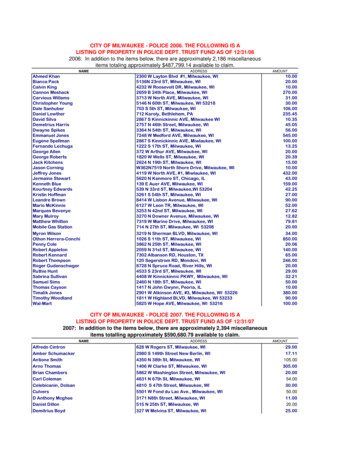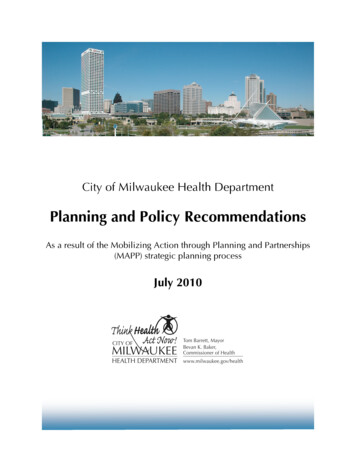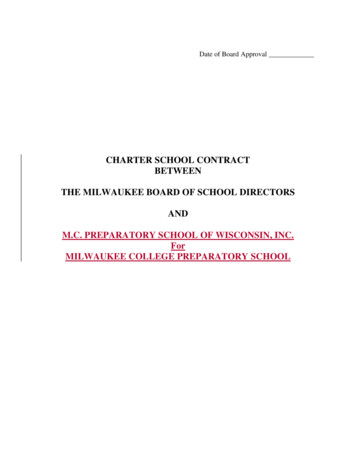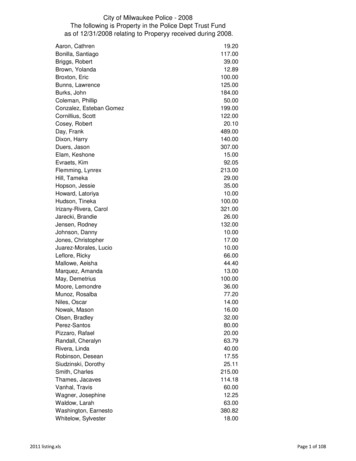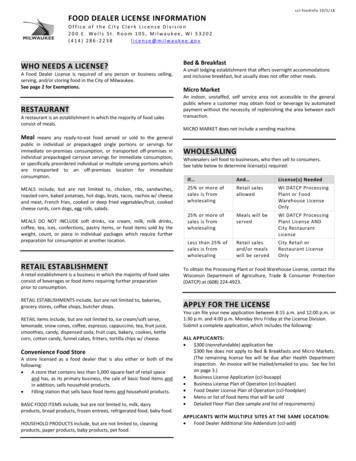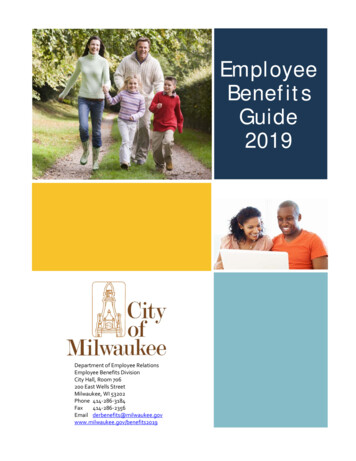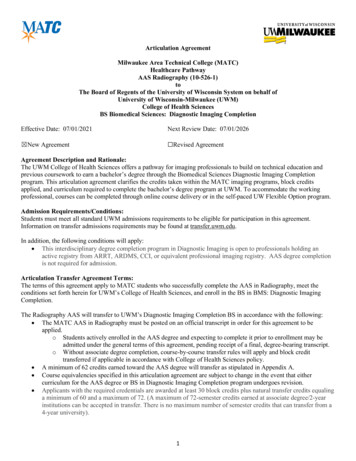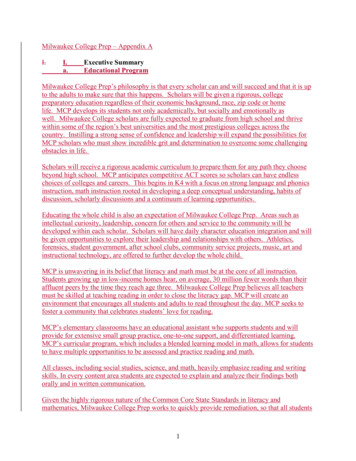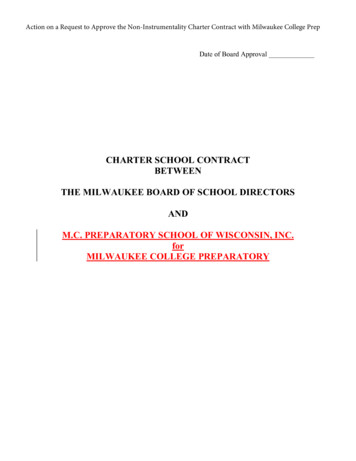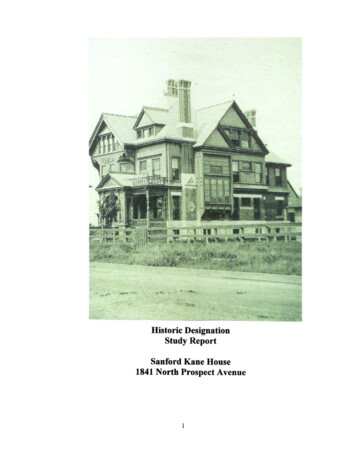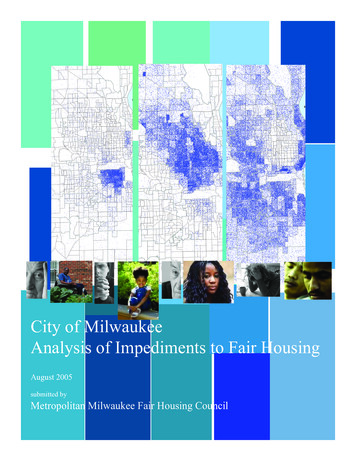
Transcription
119600 COUNTY LINE RD9Number of Black Residents Number of White ResidentsMilwaukee CountyMilwaukee County246791012Number of Hispanic ResidentsMilwaukee County9600 COUNTY LINE RD9600 COUNTY LINE RD8800 BROWN DEER8800 BROWN DEER8800 BROWN DEER8000 BRADLEYHispanic Residents7200 GOOD HOPE1 Dot 58000 BRADLEY8000 BRADLEYW7200 GOOD HOPE6400 MILLBlack Residents7200 GOOD HOPE1 Dot 64005 MILL5600 SILVER SPRING6400 MILL4700 HAMPTON5600 SILVER SPRING5600 SILVER SPRING4700 HAMPTON4200 CAPITOL4700 HAMPTON3100 BURLEIGH4200 CAPITOL3100 BURLEIGH4200 CAPITOL2300 NORTH1700 WALNUT1200 JUNEAU2300 NORTH3100 BURLEIGH700 WISCONSIN1700 WALNUT100 PIERCE1200 JUNEAU2300 NORTH1400 GREENFIELD700 WISCONSIN1700 WALNUT100 PIERCE1200 JUNEAU2300 LINCOLN1400 GREENFIELD700 WISCONSIN3100 OKLAHOMA100 PIERCE3900 HOWARD2300 LINCOLN1400 GREENFIELD3100 OKLAHOMA4700 LAYTON2300 LINCOLN3900 HOWARD5500 GRANGE4700 LAYTON3100 OKLAHOMA6300 COLLEGE5500 GRANGE3900 HOWARD7100 RAWSON6300 COLLEGE7900 DREXEL4700 LAYTON7100 RAWSON8700 PUETZ5500 GRANGE7900 DREXEL9500 RYAN6300 COLLEGE8700 PUETZ10300 OAKWOOD7100 RAWSON11100 COUNTY LINE RDSource: U.S. Census 2000, SF3, Table P004NonProfit Center of Milwaukee - 20049500 RYAN7900 DREXEL10300 OAKW11100 C8700 PUETZCity of MilwaukeeAnalysis of Impediments to Fair HousingSource: U.S. Census 2000, SF3, Table P0049500 RYAN10300 OAKWOOD11100 COUNTY LINE RDSource: U.S. Census 2000, SF3, Table P004August 2005submitted byMetropolitan Milwaukee Fair Housing CouncilNonProfit Center of Milwaukee - 2004
Author of the ReportThis report was produced by the Metropolitan Milwaukee Fair HousingCouncil, Inc. (MMFHC). MMFHC was established in October 1977 as aprivate, non-profit organization dedicated to promote fair housing throughoutthe State of Wisconsin by guaranteeing all people equal access to housingopportunities and by creating and maintaining racially and economicallyintegrated housing patterns. These goals are accomplished through fourmajor program components: Enforcement, Outreach and Education, Trainingand Technical Assistance, and Community and Economic Development.MMFHC’s Enforcement Program provides direct assistance to personsalleging violations of federal, state and local fair housing laws. Institutionalforms of housing discrimination are also uncovered through systemicinvestigations conducted by the Council. Under MMFHC’s Outreach andEducation activities, thousands of consumers, housing providers, housingadvocacy, civic and educational organizations are provided information onfair housing laws, procedures and issues in efforts to expand equal housingopportunities. MMFHC’s Community and Economic Development Programincludes activities addressing affordable housing, land use, housing policyanalysis, fair lending services and MMFHC’s Strategies To OvercomePredatory Practices (STOPP), its anti-predatory lending program.MMFHC provides services throughout the State of Wisconsin through threeoffices. Its main office is located in the City of Milwaukee and satellite officesof the organization are located in Madison (Fair Housing Center of GreaterMadison) and Appleton (Fair Housing Center of Northeast Wisconsin).This Analysis of Impediments to Fair Housing report was funded entirely bythe City of Milwaukee through the Community Block Grant Administration.The Nonprofit Center of Milwaukee’s Data Center provided MMFHC withmapping services, data analysis and software technical assistance.Cover photos provided by Michael Peragine, IndependenceFirst and sxc.com.
table of contentsExecutive SummaryIntroductioni-x112Demographic and Economic Characteristics351114151619202225Fair HousingScope of StudyRacial CompositionHousehold ProfilesHomeownershipAge DistributionEmployment and IncomeHousing Supply CharacteristicsEducationMetropolitan SegregationLinguistic IsolationFair Housing Impediments27City of Milwaukee: Procedures, Policies and Practices28Housing/Employment Discrimination Ordinance28Accessible Housing30Substandard Housing31Affordable Housing Supply32Group Homes or Community Living Arrangements 37CDBG Funding Policies38Fair Housing Activity38MPS Policies40
table of contentsState and Federal PoliciesSection 8 Housing Choice VouchersRegional Housing StrategyCommunity Reinvestment Act (CRA)Smart GrowthDevelopers Resources and IncentivesWHEDA Tax Credit AllocationInfrastructure Between Medicare and Section 8Suburban PoliciesPrivate Market ImpedimentsHousing ProducersMortgage LendingHomeowners InsuranceReal Estate and Rental 61Appendices69697183Appendix A: Data Gathering MethodologyAppendix B: Milwaukee’s Segregation TimelineAppendix C: Milwaukee CDBG Funded Activities
executive summaryThe “City of Milwaukee: Analysis of Impediments to Fair Housing 2005” should be used as ameaningful tool for the community to take steps to ensure equal access to housing opportunities forall persons in the City of Milwaukee. This study contains an analysis of demographic and economiccharacteristics in relation to their impact on fair housing; a discussion of fair housing impediments;and a series of recommendations designed to dismantle the impediments identified.Demographic and Economic CharacteristicsAn analysis of the demographic and economic characteristics in Milwaukee assists in identifyingtrends that currently have or will have an impact on Milwaukee’s housing market and impedimentsto fair housing choice. Some of the major findings include: Since 1970, the City of Milwaukee’s proportion of the four-county regional population hasdecreased. Minorities comprise 50% of the City’s population but only 3% of the outlying suburbanpopulation. Hispanics and Asians experienced the most pronounced population increases, partially dueto an influx of foreign-born persons. The percentage of overcrowded households increased, particularly in areas with largerHispanic populations. Despite homeownership gains among all races and ethnicities, a large racial disparity stillexists. Unemployment rates for blacks, Latinos, Asians, and American Indians are significantlyhigher than those of whites in the City of Milwaukee. All of the net job growth in the metropolitan area has occurred in the suburbs, yet 32.3%of Milwaukee’s black households do not own cars. Latinos are nearly 3 times as likely as whites not to have a high school diploma, and Asiansand African Americans are over 2 times as likely as whites not to have a high schooldiploma. The City has 46 census block groups in which 16-40% of the households are linguisticallyisolated.Fair Housing ImpedimentsAn impediment to fair housing is anything that may hinder or prevent a person from having equalaccess to housing because of their membership in a Federal or State of Wisconsin protected class.i
executive summaryImpediments may take the form of a city or other governmental entity’s policy, practice or procedure,housing industry practices, or other societal factors that may contribute to impeding a person orfamily from obtaining housing. The Metropolitan Milwaukee Fair Housing Council’s (MMFHC)research and interviews with community representatives helped identify the impediments listedbelow.City of Milwaukee ImpedimentsLack of Required Enforcement Mechanism for Complaints of Discrimination: Because the EqualRights Commission has been merged into the Department of Employee Relations, the City does nothave the capacity to conduct intake or investigation of housing discrimination complaints.City of Milwaukee Housing and Employment Discrimination Ordinance: The ordinance includesprovisions that are inconsistent with, and in some instances more restrictive than, federal and/or state fair housing laws. Moreover, the Ordinance provides vague and inadequate enforcementmechanisms for persons who bring claims under this Ordinance.Lack of Housing Units Accessible to Persons with Disabilities: Based on interviews withIndependent Living Centers in Wisconsin, persons with disabilities in the City are more in need ofaffordable and accessible housing than those without disabilities.Overcrowded Housing: The prevalence of overcrowded housing conditions was raised duringinterviews with community organizational representatives. It is of concern that new immigrantfamilies may be doubling up, have larger families, or be living as an extended family with severalgenerations under one roof.Affordable Housing Supply: Currently, 39% of Milwaukee households pay 30% or more of theirincome for rent. Impediments that contribute to the shortage of affordable housing are the lack offinancial resources to build and preserve affordable housing, the Housing Authority of the City ofMilwaukee’s (HACM) inadequate supply of Housing Choice Section 8 Rent Assistance Vouchers,and limited landlord participation in the Section 8 program.Group Homes or Community Living Arrangements (CLA): The City can deny a CLA an occupancypermit if it within 2,500 feet of another CLA. Advocates for persons with disabilities have alreadywaged successful legal challenges against ordinances, such as the City’s. These challenges assertedthat these types of ordinances were too restrictive and were found to have violated the Federal FairHousing Act.Community Development Block Grant (CDBG) Funding Policies: The Community DevelopmentBlock Grant funding process and priorities can be an impediment to maximizing resources foraffordable housing production, rehab and preservation. Impediments identified include: the City’sfailure to leverage Block Grants for increased private investment; Block Grant dollars are increasinglyallocated to fund City departments; and the lack of post-purchase housing counseling.Fair Housing Litigation Involving the City:Two major fair housing legal actions initiated against the City, in the last ten years are describedbelow. In each case the plaintiff prevailed.ii
executive summary U.S. Department of Justice v. City of Milwaukee in which the City denied a zoning varianceto the Indian Council for the Elderly. It was alleged the discriminatory motives of localresidents and a member of the Milwaukee Common Council representing the district inwhich the senior center was to have been constructed impermissibly influenced the City’saction. Local residents and a member of the Milwaukee Common Council vocally opposedthe construction because they believed that Native Americans would visit it. Oconomowoc Residential Programs and Wisconsin Coalition for Advocacy v. City ofMilwaukee, in which the City of Milwaukee failed to make a reasonable accommodation—required by the Americans with Disabilities Act and the Fair Housing Amendments Act—indenying a zoning variance for a group home. The plaintiffs sought a variance from a Cityordinance that prohibited community living arrangements within 2,500 feet of one another.The court rejected the City’s reasonable accommodation and undue financial burdensarguments. The plaintiffs, the court held, met their burden of demonstrating that the variancewas necessary to give them an equal opportunity to live in a residential neighborhood.Milwaukee Public Schools (MPS)Challenges facing MPS have generated a number of responses. Some of those responses have takenthe form of the development of alternative school options for area students. In theory, such optionscould serve to improve the desirability of MPS and thus increase housing opportunities and racialintegration in the City. In practice, however, these school initiatives, while well intended, mayhave a negative impact on the City’s and the Region’s racial and economic segregation. The foursuch initiatives discussed in the body of this report are: Chapter 220, the Neighborhood SchoolsInitiative, Open Enrollment, and the Milwaukee Parental Choice Program.State and Federal Housing Policy ImpedimentsWhile the City of Milwaukee is not directly involved in these state and federal impediments, theymust be addressed as they impact the City’s ability to “affirmatively further fair housing”1. Stateand federal impediments are:Cuts in funding to the Section 8 Housing Choice Voucher Program: These cuts impede localcommunities’ ability to assist their population in finding quality, affordable housing.No Regional Housing Strategy or Plan: Metropolitan Milwaukee needs to expand the rangeof housing options available, particularly for low- and moderate-income households.Attack on the Community Reinvestment Act (CRA): Attack on CRA by some banking regulatorshurts low- and moderate-income neighborhoods.Efforts to Weaken Wisconsin’s Smart Growth/Comprehensive Planning Law: These efforts“Affirmatively further fair housing” (AFFH) is language that comes from the mandate of Section 808 (e)(5) of theFederal Fair Housing Act which requires the Secretary of HUD to Administer the Department’s housing and urbandevelopment programs in a manner to affirmatively further fair housing. The extent of the AFFH obligation has neverbeen defined statutorily. However HUD defines it as requiring a grantee to (1) Conduct an AI, (2) Take actions toovercome impediments identified through the AI and (3) Maintain records reflecting the analysis and actions taken.1iii
executive summarycontinue to threaten the inclusion of public participation and local control of planning issues. Inaddition, the existing law contains no enforcement mechanism, only goals, to meet the housingneeds of persons with special needs, of all income levels and of all age groups.The Lack of Resources and Incentives for Affordable Housing Developers: This lack of resourcesplaces the City in the position of either having a shortage of housing for the lowest-incomehouseholds or having to subsidize affordable housing development.Wisconsin Housing and Economic Development Authority’s (WHEDA) Low Income HousingTax Credit (LIHTC) Program: WHEDA’s tax credit allocation scoring limits housing opportunityand contributes to the concentration of poverty as well as racial and ethnic segregation inMilwaukee.The Lack of Infrastructure Between Medicare/Medicaid and Section 8: This lack of infrastructurecosts the government more money and keeps persons with disabilities segregated and living ininstitutions instead of being integrated into society. A recent study documented that at least 1168Milwaukee County residents with disabilities desired to move out of their nursing care facilities.Although they were physically able to do so, they lacked the financial resources to make such atransition.Suburban PoliciesCurrent suburban2 policies, practices and procedures ensure that the cycle of segregation continues.Policies discussed in the text of this report include: opposition to housing for families withchildren, position to affordable housing through NIMBYism, impact fees, exclusionary zoningcodes, exclusionary public housing or Section 8 Rent Assistance Vouchers and inadequate publictransportation.There are far-reaching and deleterious effects of the suburban policies described above. They haveexacerbated the concentration of minority persons, affecting housing and employment opportunitiesand other quality of life issues. Suburban exclusionary policies promote the concentration ofpoverty in other jurisdictions in the region. In metropolitan Milwaukee, the detrimental effects ofthis fall squarely on the shoulders of the City in the form of disparate incomes along racial lines,educational attainments, the ability to build wealth, and the ability to access quality employment,as well as access to other life-improving services.Private Market ImpedimentsPrivate market impediments are obstacles to fair housing in the housing production, mortgagelending, homeowners insurance, rental, and home sales markets. Though Milwaukee is limited inits ability to directly address private market impediments, it can take a leadership role in bringingthese issues to the public’s attention.Housing Production: The main impediment to fair housing in housing production is attributedto a lack of programs that provide financial incentives to developers to build accessible housing,2Suburban, for the purpose of this report, pertains to every municipality in the Metropolitan Statistical Area otherthan the City of Milwaukee.iv
executive summaryaffordable housing or larger housing units to accommodate large families.Mortgage Lending: Discrimination in mortgage lending prevents or impedes home seekers fromobtaining the financing normally required to purchase a home. The major impediments identifiedinclude:Predatory lending: These are loans designed to exploit vulnerable and unsophisticatedborrowers. Deregulation of the banking industry in the late 1990s left many of Milwaukee’sneighborhoods vulnerable to predatory lending practices.Lack of Spanish and Hmong-speaking lenders: For non-English speaking persons new tothis country, or for persons more comfortable speaking another language, obtaining a homemortgage can be a challenging endeavor. Because non-English speaking persons seeking amortgage often have to rely on their children or other family members to translate, errorsand misunderstandings are more likely to occur.Lack of flexible underwriting to accommodate persons with no credit history: Personsnew to this country have not established the credit typically required to obtain a primemortgage and many people of color do not have a business relationship with conventionalbanks. These situations may complicate their abilities to obtain mortgages and make itmore challenging for lenders to use conventional underwriting guidelines, thus creating anobstacle to homeownership.Loan Originations and Denials: Although residential lending per household in the City’slow-income lending Target Area (TA) occurs only about half as often as in the metropolitanarea, lending in the TA did grow at a faster rate from 1999 to 2003 than elsewhere in the Cityor metropolitan area. Loans per thousand households grew 34% in the TA during this timeperiod, while increasing 21% in the City and 12% in the metropolitan area. Denial ratesfor conventional loan applications in the TA continue to be high (20% in 2003, comparedto 16% in 1994) but have dropped in recent years (from a peak of 28.5% in 2000). Incontrast, the denial rate for conventional loan applications in the entire metropolitan areais only 7.9%3Subprime Lending: The availability of subprime loans increases the homeownershipoptions for people with less than perfect credit. However, many subprime loans maycross the line and become predatory loans. In 2000 subprime lending made up 26.5% ofconventional loans in the TA, but only 6.3% of conventional loans in the Metro area. Ofthe refinance loans, 43.6% of the loans in the TA were subprime, compared with 12.4% inthe Metro area.Subprime lending is also heavily concentrated in minority neighborhoods; homeownersin predominately minority neighborhoods are almost 12 times more likely to receive asubprime refinance loan than homeowners in predominately white neighborhoods.434City of Milwaukee 2005 Annual Review of Lending Practices of Financial InstitutionsACORN, 2004v
executive summaryLending Gap: Milwaukee has the largest denial rate disparity of the 50 largest USmetropolitan areas. The data behind this disparity are complex. While metropolitanMilwaukee whites experience a loan denial rate much lower than elsewhere in the country(7.4% in Metropolitan Milwaukee compared to 13.8% for the national average), minoritiesin the metropolitan Milwaukee area are denied loans at a slightly higher rate than thenational average (23.1% in metropolitan Milwaukee compared to 21.7% nationally).5Homeowners Insurance: Discrimination in the procurement of homeowners insurance is anotherway that fair housing choice is impeded. Racial discrimination in the provision of insurance not onlydenies fair housing choice, but also fosters disinvestment and the deterioration of neighborhoods. Inaddition to racial discrimination, language barriers can be an impediment in obtaining homeownersinsurance. The complexity of homeowners insurance can be exacerbated when homeowners speaklanguages other than English, or for whom English is a second language.Real Estate Purchase and Rental Markets: A major impediment to housing choice is discriminationin the sale and rental of housing. Racial discrimination remains the major form of discriminationin the housing market and there is evidence that despite legislation and enforcement efforts, it hasnot diminished. In addition, with the burgeoning Hmong and Latino populations, it is important toensure an equal level of service by housing providers be available to alleviate this impediment tofair housing choice.Advertisements of rental units or homes for sale also may contain overt or subtle forms ofdiscrimination. Advertisements that state restrictions such as “Adults Only” or “English speakingpreferred” are obvious examples of such discrimination. In Milwaukee recent examples ofdiscriminatory advertising include printed advertisements and “For Rent” signs that have includedphrases such as “Adults Only”. Other cases filed with administrative agencies included languagein advertisements that stated “Married Couples” or “Christian handyman preferred”.RecommendationsThe most critical element of the “Analysis of Impediments to Fair Housing” is the Recommendationsthat are provided for local communities to address and remedy the barriers identified. This section,therefore, should be used as a starting point for the City to develop and implement a comprehensivefair housing action plan. The following recommendations for the City are not in any order ofpriority.Recommendation #1: Facilitate the Production of Affordable HousingFund an Affordable Housing Production Task ForceThis task force, comprised of private and not-for-profit housing experts, would be charged withidentifying and securing federal and private funds to help subsidize the development of lowincome and affordable housing.Utilize Tax Incremental Financing (TIF) to Produce Affordable HousingThe City should be more assertive in its use of TIF to create more affordable housing units. TIF5City of Milwaukee 2005 Annual Review of Lending Practices of Financial Institutionsvi
executive summaryapproval evaluation criteria could prioritize residential development projects that include affordablehousing.Reevaluate the City’s Supply of Affordable HousingThe City is in a difficult position in terms of its supply of affordable housing. Due to several factorssuch as urban disinvestment, the level of demand, and suburban exclusionary policies, a majorityof the region’s affordable housing supply is disproportionately located in the City. The City shouldattempt to address both its shortage of affordable housing, as well as the lack of affordable housingopportunities in its neighboring communities.Redefine “Affordable Housing”The City of Milwaukee should create a new definition of affordable housing using accurateand reliable indicators. Important issues to take into account should include: income of City ofMilwaukee residents, instead of Milwaukee County median income, quality of housing units andavailability of housing. Using this new definition, the City should conduct an accurate assessmentof its livable and affordable housing supply.Recommendation #2: Advocate for Changes in State and Federal Programs to ExpandAffordable Housing OptionsAdvocate for Additional Section 8 Housing Choice VouchersThe City of Milwaukee should facilitate a meeting with local US Department of Housing andUrban Development (HUD) officials, as well as Wisconsin’s US Senators and Representatives, todiscuss the adverse impact of recent HUD actions.Advocate for Affordable Housing Production ResourcesThe City of Milwaukee should facilitate a meeting with state and federal elected officials to advocatefor additional financing resources to build affordable housing, particularly for extremely lowincome persons. The City should also research successful models of affordable housing productionin other communities for possible replication in the City of Milwaukee.Advocate for Revisions to WHEDA’s Low Income Housing Tax Credit (LIHTC) Program AllocationScoringThe City of Milwaukee should advocate that WHEDA develop a scoring mechanism that (1)calculates the need for affordable housing based on the wages and salaries paid by the employersin that municipality and (2) eliminates the provision by which developments receive additionalscoring points for community support of projects.Advocate for the Creation of an Improved Infrastructure between Medicare/Medicaid and Section8According to a report by the Centers for Medicare and Medicaid a number of persons withdisabilities in Milwaukee County desired to move out of nursing care facilities. Although theywere physically able to do so, they lacked the financial resources to make such a transition. TheCity should meet with representatives of HUD and the Department of Health and Human Servicesto explore options that would allow those persons to move out of nursing care facilities and beintegrated into the community.vii
executive summaryAdvocate for a Stronger Smart Growth LawThe City should support and continue to advocate for a stronger Smart Growth Law. If allcommunities in the four county region were to include in their Comprehensive Plans, an initiativethat includes housing for persons at all income levels and needs, racial and economic integrationwould improve.Advocate for a Regional Housing StrategyThe City should advocate for the production of a Regional Housing Strategy. Communities shouldadequately plan for a practical amount of housing to serve all income levels, particularly incomelevels represented by the salaries and wages paid by employers in each community.Recommendation #3: Encourage Landlord Participation in the Housing Choice VoucherProgramThe Housing Authority of the City of Milwaukee (HACM) staff should conduct a review of wherecurrent voucher holders are living. Areas that are underrepresented by voucher holders should beidentified and targeted for increased landlord recruitment.Recommendation #4: Facilitate the Production and Modification of Accessible UnitsThe City should utilize Tax Incremental Financing (TIF) to produce more accessible housing andmore assertively use TIF to create more accessible housing units for persons with disabilities. Forinstance, TIF approval evaluation criteria could prioritize residential development projects thatinclude accessible housing.Recommendation #5: Re-establish Means to Enforce the City’s Housing and EmploymentDiscrimination OrdinanceThe City should re-establish the capacity to receive, investigate and adjudicate complaints ofunlawful housing discrimination. This local enforcement component would complement theservices provided by MMFHC and provide victims of discrimination a local source of remedy.Recommendation #6: Review and Amend the City of Milwaukee’s Housing and EmploymentDiscrimination OrdinanceThe City should review the its fair housing ordinance to ensure that it is consistent with existingstate and/or federal fair housing laws. Particular attention should be devoted to providing remediesfor victims of housing discrimination. Currently, the ordinance is explicit regarding civil forfeitures,but is vague about remedies that the victim of discrimination may recover. Absent these types ofrecoveries there is little incentive for persons to file with the City, versus other public enforcementagencies whose laws include compensatory damages, injunctive relief and recovery of attorneys’fees.Recommendation #7: Support of Comprehensive Fair Housing ServicesContinued Support of Metropolitan Milwaukee Fair Housing CouncilThe City should continue support of the Metropolitan Milwaukee Fair Housing Council, whichprovides comprehensive fair housing services in the areas of direct assistance to victims of housingviii
executive summarydiscrimination, investigations of systemic forms of illegal discrimination, outreach and educationthroughout the community, anti-predatory lending activities, and community and economicdevelopment issues.Mobility ProgramThe City should establish a program that provides assistance to persons desiring to make prointegrative housing moves, either in the rental or sales markets. Assistance would take the formof counseling about non-traditional neighborhoods, neighborhood tours, community profiles tomarket City neighborhoods and financial incentives, such as down payment or security depositassistance. This would also include a Mobility Assistance Program for Housing Choice VoucherHolders to help facilitate economic integration and residential desegregation.Fund a Regional Equity AuditThe City should fund a Regional Equity Audit. This audit would be a project to research andinvestigate procedural or policy actions undertaken by other communities that have the result offurthering or reinforcing racial and economic segregation between the City and its suburbs.Recommendation #8: Continue Support and Increase Participation in MMFHC’s AntiPredatory Lending ProgramThe City should continue its support of MMFHC’s anti-predatory lending program, Strategies ToOvercome Predatory Practices (STOPP). STOPP is critical to combat illegal lending practicesin the City of Milwaukee. This collaborative network of lenders, housing counseling agencies,community groups, Legal Aid Society and government representatives has successfully initiatedmeasures to reduce these abusive loans in the City.Recommendation #9: Support Consumer Rescue Fund for Victims of Predatory LendingThe City of Milwaukee should use its relationships with responsible area lenders, urging them towork with MMFHC and Fannie Mae to participate in a Consumer Rescue Fund (CRF). CRF loansremediate and refinance predatory loans by providing the consumer a loan they can afford and isappropriate for their circumstances.Recommendation #10: Fund Post-Purchase CounselingThe City should fund post-purchase counseling services conducted
Analysis of Impediments to Fair Housing August 2005 submitted by Metropolitan Milwaukee Fair Housing Council 100 PIERCE 700 WISCONSIN 1200 JUNEAU 2300 LINCOLN 1400 GREENFIELD 7200 GOOD HOPE . WHEDA Tax Credit Allocation 43 Infrastructure Between Medicare and Section 8 44 Suburban Policies 45 Private Market Impediments 51 Housing Producers 51 .
